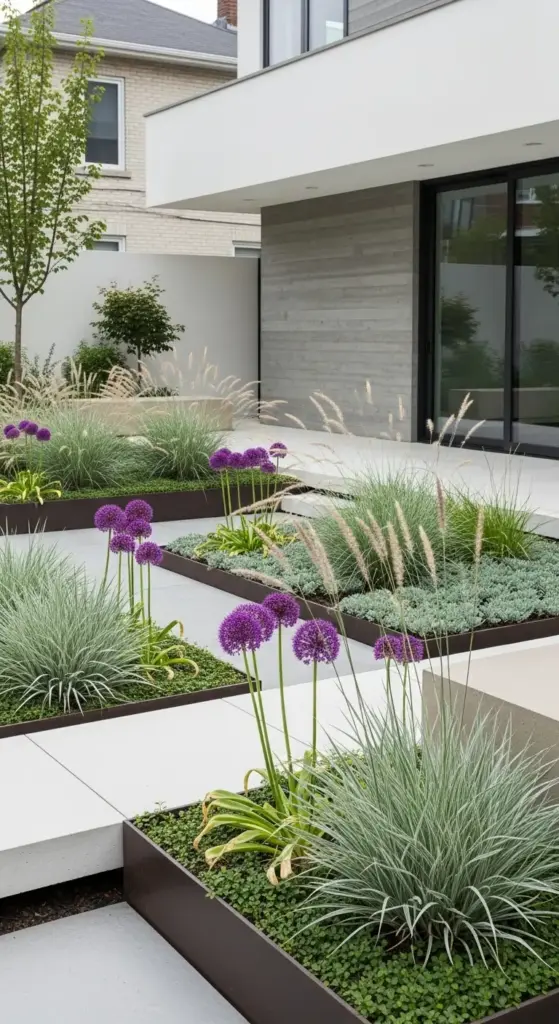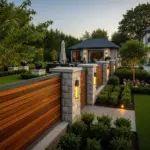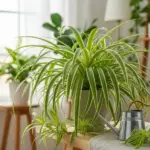2. Modern Minimalist Flower Beds: Clean Lines Meet Natural Beauty

When I moved into my sleek downtown condo, my cottage garden obsession hit a wall. Literally. The modern architecture made my wildflower chaos look completely out of place.
That’s when I discovered the magic of minimalist flower beds. Clean lines don’t have to mean boring – they just mean intentional.
Architectural Plants That Actually Look Intentional
My first attempt at contemporary garden design was a disaster. I planted random modern-looking plants without any real plan.
The breakthrough came when I started thinking like an architect. Ornamental grasses became my foundation – they provide structure year-round and move beautifully in the wind.
Fountain grass, feather reed grass, and blue fescue create those crisp vertical lines that complement modern homes perfectly. I use them like living sculptures in my geometric garden layout.
For flowering elements, alliums are absolute game-changers. Those perfect purple spheres look like they were designed by a minimalist artist.
Small Space, Big Impact Layouts
Urban gardening taught me that less really can be more when you’re working with tiny spaces. Geometric patterns maximize visual impact without overwhelming small areas.
I created a stunning rectangular planting bed using just three plant varieties arranged in clean blocks. The repetition creates rhythm and sophistication.
My go-to small space formula? One tall grass, one medium flowering perennial, and one low groundcover. Simple ratios prevent that cluttered look that kills modern design.
Monochromatic Magic
Here’s where I made my biggest rookie mistake – thinking monochromatic meant boring. Wrong!
White and silver gardens are incredibly sophisticated. I use white roses, silver artemisia, and white ornamental grasses for a palette that glows at night.
For drama, try an all-purple scheme with lavender, purple salvia, and dark-leaved heuchera. The monochromatic color palette creates depth through texture rather than competing colors.
Green-only gardens work beautifully too. Different shades and textures of green create a calming, spa-like atmosphere perfect for modern outdoor living.
Drought-Smart Plant Choices
Living through California’s water restrictions changed everything about how I garden. You can’t fake sustainability in modern design.
Agave, yucca, and ornamental grasses thrive in drought conditions while maintaining that architectural look. These low-water plants actually look better with minimal irrigation.
Sedum varieties provide groundcover that’s both water-wise and visually striking. Their succulent textures add modern appeal while requiring almost zero maintenance.
In Dallas heat, I’ve seen Mexican buckeye and native salvias perform beautifully in minimalist designs. Native plants often have the cleanest, most architectural forms.
Seamless Indoor-Outdoor Flow
The magic happens when your flower beds integrate naturally with your patio design. I learned this the hard way after creating a beautiful garden that felt completely disconnected from my outdoor living space.
Raised planters at seating height create natural boundaries while maintaining sight lines. They also double as extra seating during parties.
I use the same materials in my planters as my patio – concrete, steel, or natural stone. This repetition creates visual continuity that makes small spaces feel larger.
Lighting integration is crucial. I installed LED strips under planter edges that highlight the clean lines at night.
Low-Maintenance Schedules for Real Life
Let’s be real – maintenance schedules need to fit actual busy lives, not Pinterest fantasies.
My minimalist garden requires about 30 minutes of attention per week during growing season. That’s it.
Spring: One major cleanup and mulch refresh. Summer: Weekly deadheading and monthly deep watering. Fall: Cut back grasses and divide perennials every 3-4 years.
Drip irrigation was my best investment. Set it on a timer and forget about daily watering stress.
The key is choosing plants that look good even when they’re not perfect. Ornamental grasses and architectural perennials maintain their structure even between maintenance sessions.
Want to create a garden that gives back to nature? Our next section dives into pollinator paradise gardens that attract butterflies and bees while creating stunning visual displays. Discover which native plants will transform your yard into an eco-friendly haven that kids and wildlife absolutely love!









GIPHY App Key not set. Please check settings